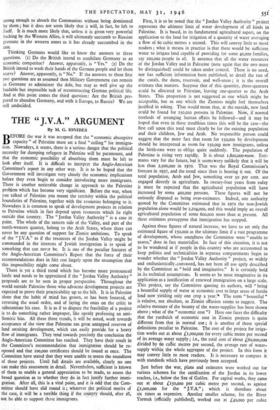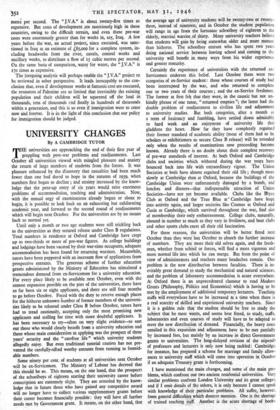THE " J.V.A." ARGUMENT
By M. G. IONIDES BEFORE the war it was accepted that the "economic absorptive capacity" of Palestine must set a final " ceiling " for immigra.- non. Nowadays, it seems, there is eserious danger that the political necessity for dumping refugees in Palestine will be paramount, and that the economic possibility of absorbing them must be left to look after itself. It is difficult to interpret the Anglo-American Committee's report in any other way. It is to be hoped that the Government will investigate very closely the economic implications before they even begin to consider introducing more immigrants. There is another noticeable change in approach to the Palestine problem which has become very significant. Before the war, when you talked of Palestine you meant the territory within the political boundaries of Palestine, together with the resources belonging to it. Nowadays it is common to speak of development projects in relation to Palestine which in fact depend upon resources which lie right outside that country. The "Jordan Valley Authority" is a case in point. The whole of the eastern side of the Valley, and part of the north-western quarter, belong to the Arab States, where there can never be any question of support for Zionist ambitions. To speak of the " J.V.A." as if the resources of the Jordan Valley might be commanded in the interests of Jewish immigration is to speak of something that can never be. It is one of the peculiar features of the Anglo-American Committee's Report that the force of their recommendations does in fa'ct rest largely upon the assumption that this impossibility might come about.
There is yet a third trend which has become more pronounced lately and needs to be appreciated if the "Jordan Valley Authority" proposals are to be seen in proper perspective. Throughout the world outside Palestine those who advocate development projects are expected to prove their practicability up to the hilt. It is in Palestine alone that the habit of mind has grown, or has been fostered, of reversing the usual order, and of laying the onus on the critic to substantiate his case. It is as if to dispute the feasibility of a project is to do something rather improper, like openly professing an anti- Semitic bias. All these three trends, it will be noted, work towards acceptance of the view that Palestine nas great untapped reserves of land awaiting development, which can easily provide for a heavy flow of immigrants. They tend towards precisely the conclusion the Anglo-American Committee has reached. They have their result in the Committee's recommendation that immigration should be re- opened and that room° certificates should be issued at once. The Committee have stated that they were unable to assess the soundness of these projects. Until full details are available, clearly no one can make this assessment in detail. Nevertheless, sufficient is known of them to enable a general appreciation to be made, to assess the broad question as to whether they do in fact justify further immi- gration. After all, this is a vital point, and it is odd that the Com- mittee should have slid round it ; whatever the political merits of the case, it will be a terrible thing if the country should, after ail, not be able to support these immigrants.
First, it is to be noted that the Jordan Valley Authority" project represents the ultimate limit of water development of all kinds in Palestine. It is based, in its fundamental agricultural aspect, on the application to the land for irrigation of a quantity of water averaging a flow of 6o cubic metres a second. This will convey 'little to most readers ; what it means in practice is that there would be sufficient water to irrigate land capable of providing for some 40,000 families, say 200,000 people in all. It assumes that all the water resources of the Jordan Valley and in Palestine (note again that the two must be distinguished) could be taken under control. There is no need, nor has sufficient information been published, to detail the run of the canals, the dams, reservoir, and well-areas ; it is the overall estimate that matters. Suppose that of this quantity, three-quarters cculd be allocated to Palestine, leaving one-quarter to the, Arab States. This proportion is not suggested as one which might be acceptable, but as one which the Zionists might feel themselves justified in asking. That would mean that, at the outside, new land could be found for iso,000 persons in Palestine. Now, if normal methods of arranging human affairs be followed—and it may be hoped that even in these troublous times this will be the case—the first call upon this total must clearly be for the existing population and their children, Jew and Arab. No responsible person could suggest that the mere fact that room for 150,000 by development should be interpreted as room for 15o,00p new immigrants, unless the birth-rate were to oblige quite suddenly. The population of Palestine is rising very rapidly. It is about r,800,0oomow. Esti- mates vary for the future, but it seems 'wery unlikely that it will be less than 2,500,000 in 1970. That was the Royal Commission's forecast in 1937, and the trend since -then is bearing it out. Of the total population, Arab and Jew, something over so per cent. are engaged directly in agriculture. In twenty-four years from today it must be expected that the agricultural population will have increased by some 400,000 persons. These figures will not be seriously disputed as being over-estimates. Indeed, one authority quoted by the Committee estimated that in 1970 the non-Jewish Population alone would be 2,204,000, and this would imply an overall agricultural population of some 600,000 more than at present. All these estimates presuppose that immigration has stopped.
Against these figures of natural increase, we have to set only the estimated figure of 150,000 as the ultimate limit if a vast programme of development, whose soundness the Committee were "unable to assess," does in fact materiatse. In face of this situation, it is not to be wondered at if people in this country who are accustomed to keep politics and technicalities in separate compartments begin to wonder whether the "Jordan Valley Authority" project, so widely and enthusiastically .canvassed, has not been all too aptly described by the Committee as "bold and imaginative." It is certainly bold in its technical assumptions. It seems to be most imaginative in its application as a justification of renewed immigration on a large scale. This project, say the Committee quoting its authors, will "bring a bountiful supply of water at economic cost to large areas of fertile land now yielding only one crop a year? The term " bountiful " is relative, not absolute, as Zionist effusion seems to suggest. The relative measure of the bounty of the water-supplies has been shown above ; what of the "economic cost "? Here one faces the difficulty that the yardstick of economic cost in Zionist projects is quite different from that in normal use ; it is another of those special definitions peculiar to Palestine. The cost of the project for irriga- tion works out at about Li,000poo for every cubic metre per second of its average water supply ; i.e., the total cost of about £6o,00o,000 divided by 0o cubic metres per second, the average rate of water- supply within the whole aggregate of the project. In this form it may convey little to most readers. It is necessary to compare it with standards which have previously been accepted.
Just before the war, plans and estimates were worked out for various schemes for the canalisation of the Jordan in its lower reaches, i.e., below the Sea of Galilee. For capital works, they came out at about £150,000 per cubic metre per second, as against £rpoopoo for the " J.V.A." ; which is therefore about six times as expensive. Another smaller scheme, for the River Yarmuk (officially published), worked out at £40,00o per cubic
metre per second. The " J.V.A." is about twenty-five times as expensive. But costs of development Are notoriously high in these countries, owing to the difficult terrain, and even these pre-war costs were enormously greater than for works in, say, Iraq. A few years before the war, an actual project, since executed, was sanc- tioned in Iraq at an estimate of 485,000 for a complete system, in- cluding headworks from the river, canals, control works and ancillary works, to distribute a flow of 15 cubic metres per second. On the same basis of comparison, water for water, the " J.V.A." is 170 times as expensive.
The foregoing analysis will perhaps enable the " J.V.A." project to be reviewed in sober perspective. It leads inescapably to the con- clusion that, even if development works at fantastic cost are executed, the resources of Palestine are so limited that irresistibly the existing population and their children will be squeezed off the land in thousands, tens of thousands rnd finally in hundreds of thousands within a generation, and this is so even if immigration were to cease now and forever. It is the light of this conclusion that our policy for immigration should be judged.































 Previous page
Previous page